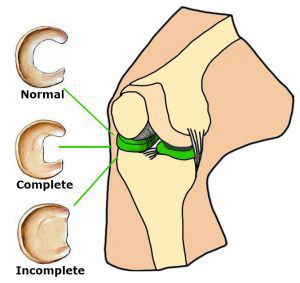Discoid Meniscus
What is Discoid Meniscus
The meniscus is a cartilage between the bones of the knee that has the shape of a crescent moon. The word meniscus means crescent in ancient Greek. The menisci help the bone of the femur and the tibia to become more congruent
There are two menisci in each knee:
- medial meniscus (inside)
- lateral meniscus (outside)
 A discoid meniscus has a different shape than a normal one. Usually it is thicker and oval or disc-shaped, like a half-moon. This abnormality makes the discoid meniscus more likely to get injured.
A discoid meniscus has a different shape than a normal one. Usually it is thicker and oval or disc-shaped, like a half-moon. This abnormality makes the discoid meniscus more likely to get injured.
Discoid lateral meniscus is the most common, and it is on the lateral side (outside) of the knee.
Depending on the shape there are two main types of discoid meniscus: complete or incomplete.
There is also a third kind called Wrisberg when the ligament that attaches the meniscus to the tibia is absent.
Discoid Meniscus Symptoms
Some people with discoid meniscus may never experience any problems in their entire life.
However in other cases, symptoms usually begins during childhood and may include: pain, swelling, stiffness, clicking in the knee.
Discoid Meniscus Cause
The cause of discoid meniscus is yet unknown, but it is a congenital disease (present at birth).
Discoid Meniscus Diagnosis
Since it is often symptomless, the orthopedic surgeon may discover it when evaluating the knee for a different problem.
However, magnetic resonance imaging (MRI) scan is the best way to have a detailed images of the soft tissues of the knee joint see the shape of the meniscus.
Discoid Meniscus Treatment
If the child doesn’t complain of symptoms treatment may not be necessary.
If the knee is painful or the discoid meniscus causes other symptoms such as swelling or popping, the orthopedic surgeon may suggest surgery, such as knee arthroscopy that is one of the most common surgical procedures for discoid meniscus.
About Prof. Portinaro
Prof. Portinaro when needed usually performs arthroscopical treatment to remove the trimmed part of the discoid meniscus but allowing intensive rehab and weight bearing.
